

Allen
Educator / Actor / Writer
Landforms: Face of the Earth. Landforms: Face of the Earth. Ancient Earth globe. Earthquakes Living Lab: The Theory of Plate Tectonics. Each TeachEngineering lesson or activity is correlated to one or more K-12 science, technology, engineering or math (STEM) educational standards.
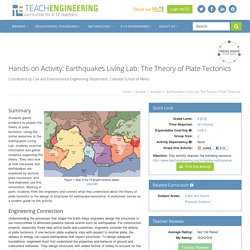
All 100,000+ K-12 STEM standards covered in TeachEngineering are collected, maintained and packaged by the Achievement Standard Network (ASN), a project of JES & Co. (www.jesandco.org). In the ASN, standards are hierarchically structured: first by source; e.g., by state; within source by type; e.g., science or mathematics; within type by subtype, then by grade, etc. Click on the standard groupings to explore this hierarchy as it applies to this document. Introduction/Motivation (It is helpful to have a world map handy to show students the continents of the Earth.) According to the theory of plate tectonics, the Earth's crust is divided into plates that are continually moving either towards or away from each other. This activity is designed around the Earthquakes Living Lab, a resource and online interface that uses real-time U.S. Drifting Continents. Summary This activity is a teacher-led demonstration of continental drift and includes a math worksheet for students involving the calculation of continental drift over time.
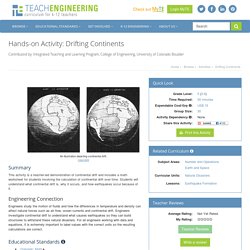
Students will understand what continental drift is, why it occurs, and how earthquakes occur because of it. Engineering Connection Engineers study the motion of fluids and how the differences in temperature and density can affect natural forces such as air flow, ocean currents and continental drift. Engineers investigate continental drift to understand what causes earthquakes so they can build structures to withstand these natural disasters. Educational Standards Each TeachEngineering lesson or activity is correlated to one or more K-12 science, technology, engineering or math (STEM) educational standards.
All 100,000+ K-12 STEM standards covered in TeachEngineering are collected, maintained and packaged by the Achievement Standard Network (ASN), a project of JES & Co. Learning Objectives Materials List Procedure. Tectonics Model - Demonstration Kit. Volcano Lava. Volcanic Hot Spots - Geology For Kids. Volcanic Hot Spots In many locations the hot molten magma from deep within the Earth rises up through the crust to reach the surface.
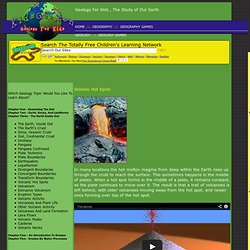
This sometimes happens in the middle of plates. When a hot spot forms in the middle of a plate, it remains constant, as the plate continues to move over it. Volcano. A volcano is a place on the Earth's surface (or any other planet's or moon's surface) where molten rock, gases and pyroclastic debris erupt through the earth's crust.
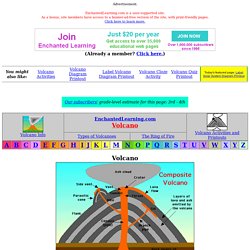
Volcanoes vary quite a bit in their structure - some are cracks in the earth's crust where lava erupts, and some are domes, shields, or mountain-like structures with a crater at the summit. Magma is molten rock within the Earth's crust. When magma erupts through the earth's surface it is called lava. How Volcanoes Work"
Whenever there is a major volcanic eruption in the world, you'll see a slew of newspaper articles and nightly news stories covering the catastrophe, all stressing a familiar set of words -- violent, raging, awesome.
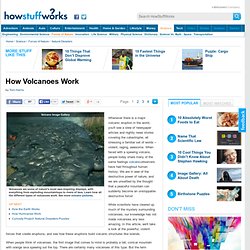
When faced with a spewing volcano, people today share many of the same feelings volcano-observers have had throughout human history: We are in awe of the destructive power of nature, and we are unsettled by the thought that a peaceful mountain can suddenly become an unstoppable destructive force! While scientists have cleared up much of the mystery surrounding volcanoes, our knowledge has not made volcanoes any less amazing. In this article, we'll take a look at the powerful, violent forces that create eruptions, and see how these eruptions build volcanic structures like islands. When people think of volcanoes, the first image that comes to mind is probably a tall, conical mountain with orange lava spewing out the top. There are certainly many volcanoes of this type. Volcano Facts, Volcano Information, Volcano Videos, Volcano Photos. Volcanoes are awesome manifestations of the fiery power contained deep within the Earth.

These formations are essentially vents on the Earth's surface where molten rock, debris, and gases from the planet's interior are emitted. When thick magma and large amounts of gas build up under the surface, eruptions can be explosive, expelling lava, rocks and ash into the air. Less gas and more viscous magma usually mean a less dramatic eruption, often causing streams of lava to ooze from the vent. The mountain-like mounds that we associate with volcanoes are what remain after the material spewed during eruptions has collected and hardened around the vent. This can happen over a period of weeks or many millions of years. Land forms. Formation of caves, stacks and stumps. Formation of Cliffs and Wavecut platforms. Formation of a Spit and Bar. Pages from Oxford Big Ideas Geography 8. MOUNTAIN LANDSCAPES. LANDFORMS AND LANDSCAPES. Investigating landscapes and their landforms Resource 7 Glossary. Investigating landscapes and their landforms Resource 6 Protecting significant landscapes.
Investigating landscapes and their landforms Resource 5 Land degradation. Investigating landscapes and their landforms Resource 4 Connecting landforms to Country Place. Investigating landscapes and their landforms Resource 3 Geomorphological hazards. Investigating landscapes and their landforms Resource 2 Geomorphic processes in action .docx. Investigating landscapes and their landforms Resource 1 Identifying landscapes and their landforms .docx.
Investigating landscapes and their landforms Matrix. Investigating landscapes and their landforms Continua. Investigating landscapes and their landforms Teacher guidelines. Investigating landscapes and their landforms Student booklet.
Bowden Brompton.